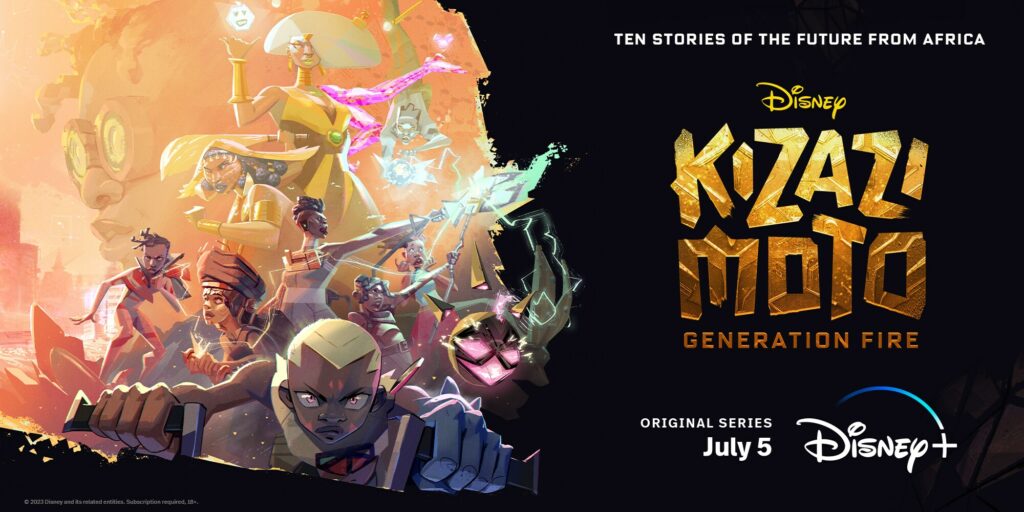Technology, Solutions and Innovations
Disney+ Embraces The African Heat
“This is all the afterglow of Black Panther and we all felt that Wakanda moment, right?” says Orion Ross, VP of Animation for Disney Europe, Middle East and Africa. “Kizazi Moto doesn’t claim to tick the African box, there are still more stories to tell, and this is only the beginning.”
What is Kizazi Moto? It’s a 10-part animated anthology that pulls together a diverse collection of animation styles and assembles an ensemble of African creatives who are telling authentically African stories.
The process started way back when Triggerfish animation studios used the Wakanda revolution as a catalyst to tell more stories from the perspective of creatives who live on the continent.
“Wakanda was the Hollywood version of an African future, we wanted to show Africa’s version,” explains Anthony Silverston, Triggersfish creative director and Executive Producer of Kizazi Moto.
Silverston, Tendayi Neyeke and Oscar-winning director of Spider-Man: Into the Spider-Verse Peter Ramsey are the executive producing trio that offered guidance and support to the anthology directors throughout the project since it was first greenlit in June 2021.
The 10 projects were selected from an initial submission pool of more than 70 ideas and the stories were crafted with input from Kadi Tay, Sidney Kimbo-Kintombo (an animator who worked on Avengers: End Game) and Bridget Pickering.
Authentic African stories
Kizazi Moto takes viewers on a wild ride from an alternate dimension where Zimbabwe was never colonised and sends aid to a destitute Canada (Mukudzei, directed by Pious Nyenyewa and Tafadzwa Hove), all the way to a genocide on the ocean floor where two tribes are locked in generational combat between sea and land people (Hatima, directed by Terence Maluleke and Isaac Mogajane).
Most importantly, the anthology showcases a strong connection between artists who create using modern tools and the cultures and history that shaped them.
“For a long time, Africans were not allowed to play in this animation space,” explains Herderboy director Raymond Malinga. “We’re now being given the space to show interesting perspectives that have never been shown before.
Malinga’s short – each film is only around 10 minutes long – demonstrates some of the challenges that the creatives faced when conveying the stories. It is set at on the wild frontier of the Chewzi Kingdom of future Uganda.
The village is never shown, only the cyborg cattle that produce precious Chwezinite from their horns, along the elite force of warrior herders who must defend the cattle from deadly spirits.
It’s a masterclass in brevity and efficient storytelling where the viewer is expected to fill in the missing pieces using a collection of visual clues. This has become second nature to animation audiences that have matured on the story vocabularies of Anime but can be challenging for those who don’t speak the visual language.
“We all have fully imagined universes where these stories take place, but we can only show you a window into that world. As creatives or responsibility is to set the lexicon that the audience can follow, we’ve all seen enough animation to know what’s going on,” says You Give Me Heart director Lesego Vorster.
Responsible representation
Vorster’s commentary on the pressures of social media and its dehumanising effects also doesn’t waste time getting into the meat of the story and is one of the few stories with a male lead.
All the directors worked separately, so the two themes of strong ancestral connections and female-focused stories occurred organically – to a point where the producers asked Surf Sangoma (a dark sci-fi thriller set in dystopian Kwa-Zulu Natal) directors Nthato Mokgata (aka Spoek Mathambo) and Catherine Green to gender swap the lead character to a male.
Projects like Moremi by Nigerian director Shofela Coker, Kenyan Ng’endo Mukli’s breathtaking Enkai tale of a mother torn between protecting the earth and spending time with her daughter further stress a more matriarchal view of African society.
While Simangaliso Sibaya’s Mkhuzi: The Spirit Racer and Tshepo Moche’s First Totem Problems grapple with the generational tensions introduced by the legacy of the elders.
As a whole the sub-Saharan projects all speak richly of the ancestral baggage that these creators carry and must contend with, as well as the emergence of females as the true community leaders.
It is only Stardust by Egyptian Ahmed Teilab that focuses on the lead character standing apart from the elders or ancestors and forging a new – if predetermined – path forward.
Kizazi Moto: Generation Fire achieves a lot for the continent and is beacon for budding African animators to look towards as a vision of what is possible.
The anthology builds on the foundations laid in Hollywood – think the soaring towers of Wakanda in Black Panther and the hand-drawn aesthetic of the Spider-Verse – but also propels the local industry forward.
There is something for everyone in this eclectic mix of animated shorts and, if Orion Ross’ excitement is anything to go on, Disney could be serving another buffet soon. Kizazi Moto is streaming now on Disney+.






 Sign-up and receive the Business Media MAGS newsletter OR SA Mining newsletter straight to your inbox.
Sign-up and receive the Business Media MAGS newsletter OR SA Mining newsletter straight to your inbox.